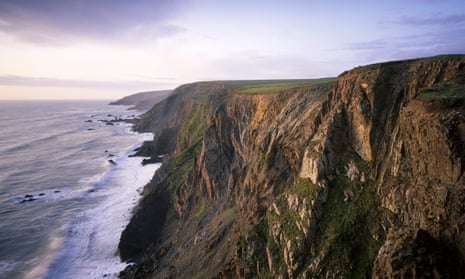Apparently the area where I grew up is one of the furthest places from a train station in Britain. It’s a place of huge cliffs, wide, stony beaches, trees bent over like fishermen. When rain comes in sideways, or gales brew up, there’s nowhere to hide. I once saw someone blown across the street into a shop window. Isolated is how it’s most often described. But for almost half the year it’s the opposite: full to the brim with holidaymakers.
It was strange, I suppose, growing up with this kind of disparity, where the place I lived changed so radically from season to season. Beaches were suddenly packed. Cars jostled for spaces. Lights came on in holiday houses. It felt like mine and not-mine at the same time. I played tennis, but in the local town, Bude, it was often too busy to get a court. Mum would go shopping early, before everything ran out.
As for my shopping habits, I knew where to get the best fudge and ice-cream, the best chips, pasties and takeaways. I was a connoisseur of Cornish junk food. There weren’t really any high street shops, so I coveted baskets of shells and tie-dye. I bought my family birthday presents from tourist gift shops or surf shops, with their sweet, rubbery smell of wetsuits and board wax.
Surf culture was everywhere. Most cars had a board strapped to the roof. It was in the language too: the sea described in terms of wave quality – mushy, glassy, crumbly. Lifeguards would work all summer, then go abroad to surf or teach skiing all winter.
People came and went with the seasons. Kids at school, whose parents worked at the satellite station on the cliffs would disappear for months then come back talking of Cyprus or Singapore. My best friend was born on Ascension Island.
It was also a place of strange connections. Communication cables come in under beaches. Seeds drift in from Africa. Messages are found in bottles. Maybe I’m drawn to this strangeness because of the series I grew up reading. I devoured Goosebumps, Point Horrors, the super-thriller strand of Sweet Valley High. The weird stuff in those books became mixed up with memories and anecdotes: the time our school burned down, a dead dolphin washing ashore, a cow falling off a cliff. There’s an uncanny quality to the coast – the tideline is strewn with cuttlebones, mists billow in.
All this has been absorbed into my writing and there are themes and subjects I keep coming back to: flux and stasis, ghostliness, what it means to belong. And of course the sea, impossible not to write about once you know the particular way it sloshes in the ears and stomach; the taste of a sea foam custard pie.
I circle back to these things like I’ve circled back to the place itself. My imagination is stubbornly lodged. It’s those lights in the half-empty houses. It’s those mists. Maybe it’s the chips. It’s about never knowing what might wash in.

Comments (…)
Sign in or create your Guardian account to join the discussion